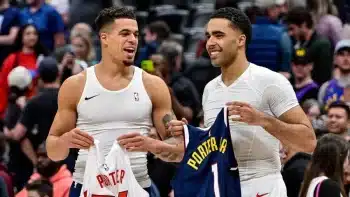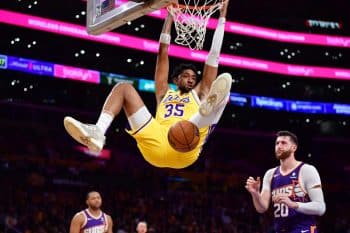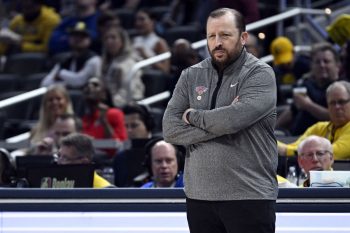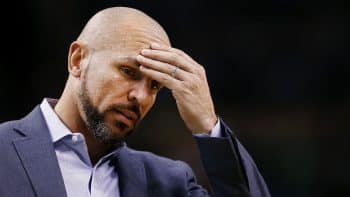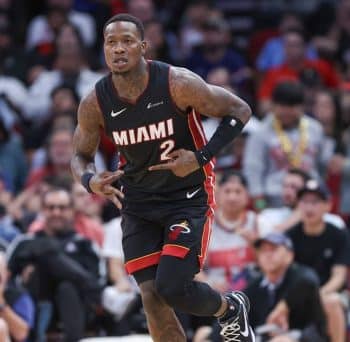NBA
NBA Daily: The NBA’s One-And-Done Moment

On Friday, a massive scandal erupted as Yahoo! Sports published court documents obtained in a federal investigation of NCAA men’s basketball. The documents implicate at least 20 programs and 25 players in potential rules violations regarding improper payments and benefits. Prior to Sunday’s Detroit Pistons game in Charlotte, coach Stan Van Gundy lit into the NCAA when asked about the scandal.
“The NCAA’s one of the worst organizations, maybe the worst organization in sports,” said Van Gundy. “And they certainly don’t care about the athletes.”
Van Gundy gave an in-depth critique of the “one-and-done” rule, whereby the NBA only allows players to become draft-eligible one year after their high school class graduates. The rule forces players with clear NBA talent to either play a single season of college basketball domestically or play a professional season overseas as Knicks point guard Emmanuel Mudiay did in China.
“I don’t understand why, as an industry, basketball or any other professional sport, that we’re able to artificially limit somebody’s ability to make money,” said Van Gundy. “I don’t get it. An 18-year-old, if he’s talented enough, can come into your profession and get a job. We’ve got the stories of some of these great tech guys that have dropped out of college and gone and made big money. They’re allowed to do that but athletes aren’t?”
Van Gundy went on to describe the rationale of certain people in favor of one-and-done as racist.
“The people that were against [high school players] coming out made a lot of excuses but I think a lot of it was racist, quite honestly,” said Van Gundy. “And the reason I’m going to say that is I’ve never heard anybody go up in arms about, oh my God, they’re letting these kids come out and go play minor league baseball, or they’re letting these kids come out and go play minor league hockey.
“They’re not making big money, and they’re white kids primarily, and nobody has a problem. But all of a sudden now, you’ve got a black kid that wants to come out of high school and make millions. That’s a bad decision? But bypassing college to go play for $800 a month in minor league baseball, that’s a fine decision? What the hell is going on?”
Oklahoma City Thunder forward Carmelo Anthony spent much of today’s media availability addressing questions about the NCAA’s latest issues and how it could impact the NBA’s stance on one-and-done.
“Amateur sports has been corrupt for so long,” said Anthony. “It’s going to force the NBA to step up and kind of take that age limit rule out.”
There is a sense in NBA circles that, while all sides agree that change is needed, it could be slow in coming. The G-League is envisioned as a resource to help young players develop and reach the NBA, but some feel it isn’t ready for an influx of players straight out of high school.
“We’re conflicted, to be honest,” said NBA Commissioner Adam Silver during his All-Star media availability when asked about a potential change to the one-and-done rule. “We’re outside of our cycle of collective bargaining right now, which is when we generally address an issue like that. But [Players Association Director] Michelle Roberts and I also agree that there’s no reason we shouldn’t also be discussing it right now. So we’ve had meetings with the Players Association where we’ve shared data [on] success rates of young players coming into the league.
“I think the question for the league is, in terms of their ultimate success, are we better off intersecting with them a little bit younger. Are we better off bringing them into the league when they’re 18, using our G-League, as it was designed to be, as a development league, and getting them minutes on the court there.”
Although the G-League may not be fully prepared to accommodate an influx of teenage players, Anthony suggested that it could eventually see players even younger than 18.
“You’re going to see a lot more players looking at the opportunity to go play overseas,” said Anthony of what he sees as the reaction to the NCAA’s ongoing problems. “You’re going to start to see guys … maybe before going to their senior year in high school, start trying to get to the G-League. You’re going to start seeing a lot of these different leagues, not just here in the U.S., but throughout the world start becoming more powerful because of what the NCAA is doing.”
Van Gundy’s damning assessment of the racial implications of one-and-done should prompt teams and players to re-assess how the rule impacts young players destined for the league. And it’s players just as much as the NBA itself that need to re-evaluate the situation. Through acceptance of the one-and-done rule, NBA players have helped normalize the transfer of millions of dollars in wealth from 18-year-olds — who would otherwise receive multi-year, guaranteed contracts as first round picks in the NBA Draft — to other NBA players.
Take LeBron James as an example. When James was a senior in high school, almost nobody doubted he could make an immediate impact in the NBA. Because the one-and-done rule wasn’t in effect, James was drafted without waiting a year and immediately proved he belonged. Had the rule been in force, James’ rookie salary of $4 million would have gone to another player while he waited to reach the NBA and the means to provide for his mother, who struggled to raise him alone.
Preventing 18-year-olds from reaching the NBA is a practice that NBA teams and players will have to reconsider as the latest NCAA drama unfolds. But there’s another compelling argument for ending one-and-done. Within 30 days of turning 18, almost all males in the United States are required to register with Selective Service. In the event of war and the institution of a military draft, these 18-year-olds could be conscripted into service and sent overseas to fight and potentially be killed. So, at 18, you’re old enough to fight and die for your country, but you’re not old enough to become a professional athlete and provide for your family?
While Van Gundy pointed out the inconsistency of those who favor one-and-done, the NCAA’s legal battle to avoid paying its players brings race even further into the discussion. On multiple occasions, the NCAA has cited Vanskike v. Peters — a case in which the judge ruled that a prison inmate could not be considered an employee of the prison — in arguing why it shouldn’t have to pay student-athletes. A recent citation has come in Livers v. NCAA, a case in which former Villanova multi-sport athlete Lawrence “Poppy” Livers argues that college athletes are employees and should be paid.
In its motion to dismiss the case, NCAA attorneys cite this passage from the U.S. Department of Labor’s Field Operations Handbook:
“As part of their overall educational program, public or private schools and institutions of higher learning may permit or require students to engage in activities in connection with dramatics, student publications, glee clubs, bands, choirs, debating teams, radio stations, intramural and interscholastic athletics and other similar endeavors. Activities of students in such programs, conducted primarily for the benefit of the participants as part of the educational opportunities provided to the students by the school or institution, are not work of the kind contemplated by [the Fair Labor Standards Act] and do not result in an employer-employee relationship between the student and the school or institution.”
The NCAA’s counsel asserts that “these provisions leave no doubt about the Department’s view that participants in ‘interscholastic athletics’ are not ’employees’ within the meaning of the FLSA.” But the cited passage leaves quite a bit of doubt, actually.
The key phrase is activities “conducted primarily for the benefit of the participants as part of the educational opportunities” provided by the school. The NCAA is equating for-profit athletics with student-run intramural athletics and claiming that college football and basketball national championships are conducted for the educational benefit of student-athletes, not for billions of dollars in revenue.
Livers’ counsel addressed these questions in the original complaint, stating that:
“Student performance outside the classroom is: (i) non-academic in nature; (ii) unrelated/irrelevant to an academic degree program; (iii) not for academic credit; and (iv) supposed to be restricted to 20 hours per week, recorded on timesheets maintained by the supervising staff of the NCAA member school, to limit interference with academic studies.”
The complaint further asserts that “student performance primarily benefits NCAA member schools, and provides no comparable academic or learning benefit to the student.” Rather than have these questions subjected to the rigors of trial, the NCAA instead continues to cite Vanskike v. Peters. In that decision, the judge stated, “the dispute, in this case, is a more fundamental one: Can this prisoner plausibly be said to be ’employed’ in the relevant sense at all?”
You read that correctly. The NCAA cited a case in which the court refused to hear arguments about employment status because the plaintiff was a prisoner, and thus subject to forced labor as “punishment for a crime,” the sole exception to the abolition of slavery under the 13th Amendment. Washington Post columnist Sally Jenkins summed up the court’s findings in Berger v. NCAA, another case in which the NCAA used the same precedent:
“The Seventh Circuit’s contorted reasoning bears repeating. College athletes are similar to prisoners economically because the ‘revered tradition of amateurism’ in college spanning more than 100 years ‘defines the economic reality of the relationship between student-athletes and their schools,’ the court wrote. As with inmates, asking any questions about who benefits from their work would ‘fail to capture the true nature of their relationship.’ In other words, amateurism is as confining and defining as jail.”
For the NCAA, the scope of the latest scandal will undoubtedly raise questions about amateur status and compensation for student-athletes. For NBA teams and players, the time has come for some serious soul-searching. Will the NBA and its players continue to deny 18-year-olds, who can be drafted into the military and shipped off to war, the ability to provide for their families? Will they continue to prop up the NCAA through the one-and-done rule while it continues to make dubious legal arguments, such as comparing student-athletes to convicted criminals?
